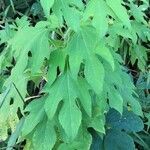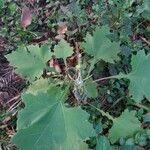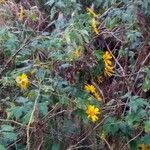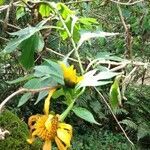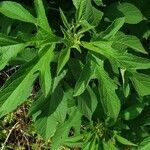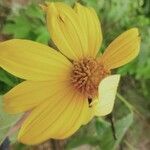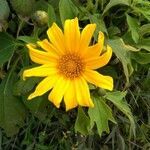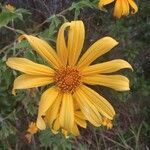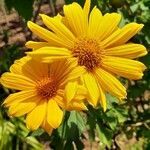Annual or short-lived perennial herb or slightly scandent shrub 0.7–3 m, often branching; stems 4-angled, pilose but soon glabrescent.. Leaves alternate, pseudo-petiolate, ovate to obovate, deeply 3–5-lobed or unlobed in some upper leaves, 6–23 cm long, 3–18 cm wide, base cuneate to attenuate, margins crenate to subentire, apex acuminate, scabrid above, pubescent to tomentose beneath; pseudo-petiole to 10 cm long, with 2 auricles 2–8 mm long at base (always?).. Capitula terminal on side branches, solitary; stalks of individual capitula to 21 cm long, widening near apex and in extreme cases the widened part to 6 cm long and 1 cm across; involucre 4-seriate, 14–20 mm long; phyllaries 5–17 mm long; paleae ± 12 mm long, pubescent or glabrous.. Ray florets 8–12, yellow or orange-yellow, tube 1.9–3 mm and pubescent, ray 40–75 mm long; disc florets cylindrical, 7.5–10 mm long, puberulous near base.. Achenes oblong, 5–6 mm long, 4-angled, pubescent; pappus of scales to 2 mm with 2 setae to 4 mm long.. Fig. 162 (page 760).
Perennial herb (1.0–) 1.5–3.5 m high; stem green to red-purple, strongly striate, glabrescent. Leaves with petiole 2–6 cm long; lamina ovate in outline, 7–15 (–33) cm long, 7–15 (–22) cm wide, entire or 3–5-lobed, shortly toothed, acuminate, minutely scabrous, glabrous or glabrescent above; base decurrent to petiole. Capitula 10–15 cm diam. (including rays), on peduncles 2–9 (–24) cm long; paleae 0.9–1.3 cm long; involucral bracts graduated, oblong to ovate, 3-or 4-seriate, distinctly striate, ± glabrous or sparsely pilose abaxially; inner bracts abruptly tapering to apex. Ray floret ligules 4–7 cm long, yellow. Disc florets numerous, c. 15 mm long; outer surface glabrous above, yellow. Achenes black or mottled, 5–7 mm long, appressed-pilose. Pappus of hard, white, fused, erose scales and 2 ± equal awns 3–5 mm long.
Coarse, stout branching herb to 3.5 m, annual, perhaps sometimes perennial. Leaves alternate, lamina up to 15 x 12 cm, more or less ovate in outline, deeply 3-5-lobed, the tips of the lobes acuminate, pubescent on both surfaces, sometimes almost velvety below, base narrowly cuneate, decurrent on the petiole in a long, gradually narrowed wing, petiole up to c. 10 cm. Heads very large and showy, up to c. 10 cm across the expanded rays, solitary on long peduncles much swollen below the heads, several together in panicles. Involucral bracts in c. 4 series, the inner with broad rounded papery tips. Rays yellow above and below, disc yellow. Achenes c. 8 mm long, narrowly oblong-obovate, somewhat compressed, appressed-hairy. Pappus of several short broad scales and 2 lateral awns, one much shorter than the other.
An annual herb. It grows 1-3 m tall. The stems are stout and rough. The leaves are alternate and oval. They have teeth around the edge. The lowest leaves can be heart shaped. The leaves are 10-25 cm long by 5 cm wide. They are hairy. The flower is large and occurs singly. It can be 20 cm across. It is yellow. The fruit is 4 angled and 1 cm long by 4 mm wide.
Annual herb, up to 3.5 m high. Involucral bracts in ± 4 series, inner with rounded, papery tips. Rays bright yellow on both sides.
